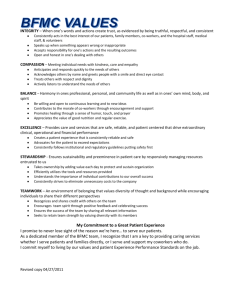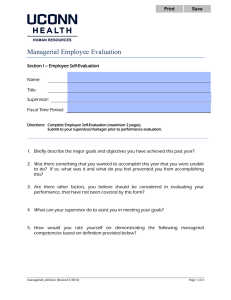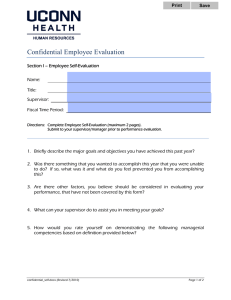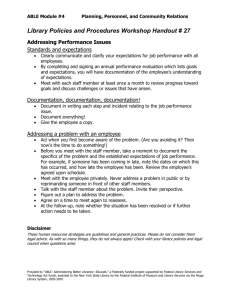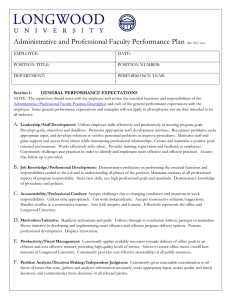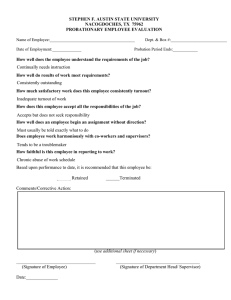Pre-K Teacher Scoring Guide 2015-2016
advertisement
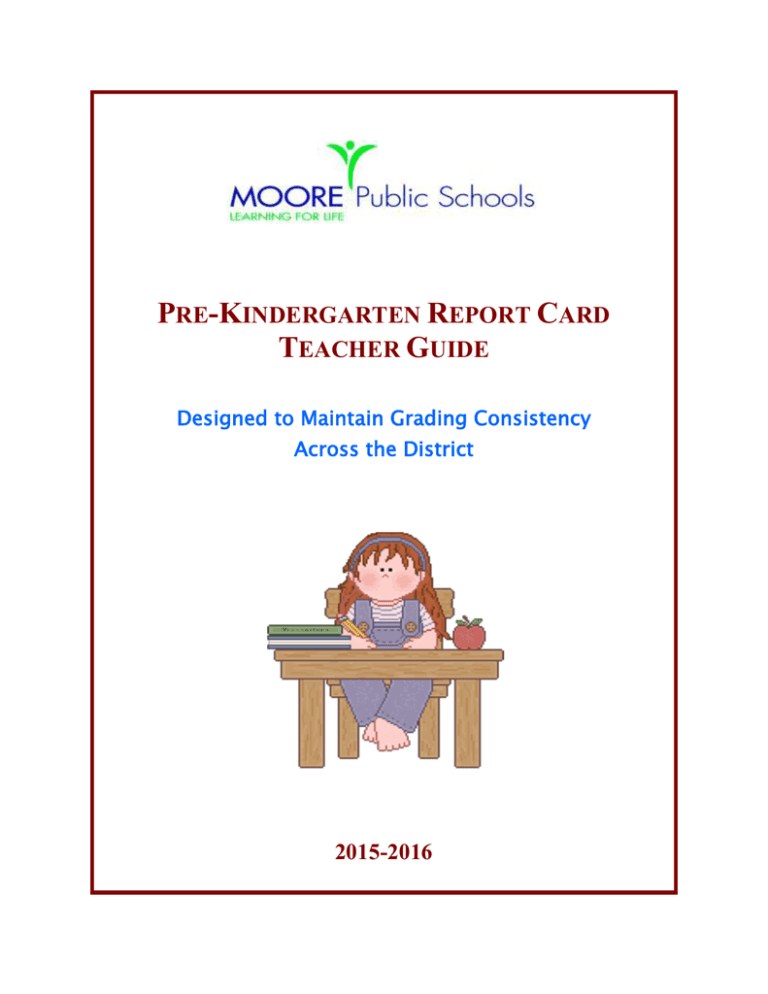
PRE-KINDERGARTEN REPORT CARD TEACHER GUIDE Designed to Maintain Grading Consistency Across the District 2015-2016 Introduction to Standards-Based Report Card All teachers are asked to use the grading guidelines so that we can maintain grading consistency across the District. We are working together to provide each child with the knowledge and skills needed to be successful. The students in your classroom are required by Oklahoma State Law to be on or above grade level in reading by the end of the third grade or they will be retained. The State of Oklahoma has developed grade level standards which identify the essential knowledge and skills that should be taught and learned at each grade level. Our standards-based Pre-Kindergarten Report Card provides written documentation regarding student attainment of these standards. It compares the students’ performance against a set of standards. It does not compare the students’ performance against the performance of other students. Therefore the teacher has a better understanding of each child’s strengths and weaknesses. A standards-based report card looks at the standards and reports how the student is progressing towards meeting the grade-level standards. We have created a Pre-Kindergarten Report Card Teacher’s Guide that provides an explanation of each assessed objective, offers suggested assessment tools, and in some cases it lists activities that can be used to measure an objective. Once a skill is introduced, instruction should continue until the achievement level specified has been reached. Teacher Guide This guide lists the assessed items as they appear on the Pre-Kindergarten report card based on PASS objectives. Under each objective is an explanation of what should be assessed or examples are provided. If an objective has no item of explanation, this means that the committee believed the objective did not need further clarification. CHARACTERISTICS FOR SUCCESSFUL LEARNERS When marking this section, the following rubric should be used: 1. Below grade level expectations 2. Demonstrates frequently 3. Demonstrates consistently, easily Easily separates from parent 1. Regularly displays anxiety (i.e. crying, failure to engage in activities) 2. Sometimes displays anxiety 3. Consistently separates from parent without anxiety Takes care of personal needs 1. Frequently requires teacher assistance 2. Sometimes requires teacher assistance 3. Consistently takes care of personal needs Respects the property of others 1. Frequently does not leave others’ things alone (school, teacher, student) 2. Sometimes does not leave others’ things alone (school, teacher, student) 3. Consistently leaves others’ things along Observes classroom and school procedures 1. Rarely observes classroom and school procedures 2. Sometimes observes classroom and school procedures 3. Consistently observes classroom rules and school procedures Takes turns and shares 1. Does not take turns nor shares 2. Sometimes takes turns and shares 3. Takes turns and shares Practices self control 1. Never in control of body movements and motions 2. Sometimes controls body movements and motions 3. Consistently practices self-control Accepts responsibility for own actions 1. Always blames others 2. Sometimes takes responsibility for inappropriate actions 3. Consistently takes responsibility for own behavior Plays cooperatively with other children 1. Frequently requires teacher intervention during play 2. Sometimes requires teacher intervention during play 3. Consistently takes responsibility for own behavior Makes choices and stays with an activity for a reasonable length of time 1. Frequently has a hard tune choosing an activity and/or flits from activity to activity 2. Sometimes makes choices and stays with an activity for a reasonable length of time 3. Consistently makes choices and stays with an activity for a reasonable length of time Returns materials to correct place when finished with an activity 1. Always scattered supplies; lost belongings; materials not stored properly 2. Sometimes organized; frequently stores materials properly 3. Always organized; materials are stored appropriately Completes work in a reasonable amount of time 1. Always late, or last to complete work; consistently not on task 2. Sometimes on task; frequently finishing within the given time 3. Consistently on task; consistently finishing within the given time Participates in large and small group activities 1. Rarely participates in large and small group activities 2. Sometimes participates in large and small group activities 3. Consistently participates in large and small group activities Listens without interrupting 1. Never in control of speaking out. 2. Sometimes interacts without interruptions 3. Consistently listens without interrupting Strives for quality work 1. Always rushed, sloppy work 2. Sometimes working carefully 3. Consistently working for quality work SAFETY AND SECURITY When marking this section, the following rubric should be used: 1. Needs more time to develop 2. Has demonstrated but needs more consistency 3. Consistently demonstrates States first, middle, last name States birthday and age: month, day, age States house number, street, city, and state States first and last name of parent/guardian (May give one parent/guardian name) Motor Skills 1. Needs more time to develop 2. Has demonstrated but needs more consistency 3. Consistently demonstrates Uses finger pinch grasp Traces lines with control Cuts on a line Uses correct scissor grasp Completes a 10-12 piece puzzle independently LANGUAGE ARTS Oral Language – Listening and Speaking 1. Needs more time to develop 2. Has demonstrated but needs more consistency 3. Consistently demonstrates Listens with interest to stories read aloud 1. Consistently disrupts storytelling by interfering with their own or others’ listening 2. Sometimes listens with interest to stories read aloud 3. Consistently listens to stories read aloud Expresses ideas in complete sentences 1. Needs more time to develop 2. Has demonstrated but needs more consistency 3. Consistently demonstrates Follows oral directions 1. Completes zero or one part of a two part instruction 2. Sometimes completes two part instructions 3. Consistently completes two part instructions Recites simple poems, rhymes or songs 1. Needs more time to develop 2. Has demonstrated but needs more consistency 3. Consistently demonstrates Participates in conversations 1. Needs more time to develop 2. Has demonstrated but needs more consistency 3. Consistently demonstrates Pre-Reading Skills 1. Needs more time to develop 2. Has demonstrated but needs more consistency 3. Consistently demonstrates Recognizes first name in print Recognizes last name in print Matches rhyming pairs (6 pairs) (i.e. picture cards, manipulatives) (orally) 1. Matches 0-1 rhyming pairs 2. Matches 2-5 rhyming pairs 3. Matches 6 rhyming pairs Match opposite word pairs (6 pairs) (i.e. picture cards, manipulatives) (orally) 1. Creates 0-1 opposite word pairs 2. Creates 2-5 opposite word pairs 3. Creates 6 opposite word pairs Claps syllables in spoken words (clapping syllables in 6 spoken words of which each word has a maximum of 4 syllables) 1. Claps syllables in 0-1 of 6 words 2. Claps syllables in 2-5 of 6 words 3. Claps syllables in 6 of 6 words Recognizes beginning sounds in spoken words (child is able to isolate and make the beginning sound (phoneme) in 6 words) (NOT required to say the letter) 1. Makes the beginning sounds in 0-1 of the 6 spoken words 2. Makes the beginning sounds in 2-5 of the 6 spoken words 3. Makes the beginning sounds in 6 of the 6 spoken words Retells some sequences of events (orally or with cards) 1. Unable to sequence events 2. Sometimes sequences events 3. Consistently sequences events Tells what is happening in a picture 1. Needs more time to develop 2. Has demonstrated but needs more consistency 3. Consistently demonstrates Role plays reading 1. Does not use books appropriately 2. Sometimes uses books appropriately 3. Uses book correctly for intended purpose Retells a story 1. Unable to retell story 2. Sometimes retells a story 3. Consistently retells a story DEVELOPING WRITING 1. Needs more time to develop 2. Has demonstrated but needs more consistency 3. Consistently demonstrates Differentiates between writing and drawing Uses letter-like forms for writing Uses learned letters in random fashion for writing Prints first name using correct form Writes from left to right Forms identifiable letters Copies letters or words Currently on pace to reach readiness for Kindergarten by the end of the year. (Y = Yes) (N = No) Mark ‘Yes” if student scores 3’s on 80% of items assessed for Pre-Reading. Percent is figured by number of 3’s divided by number of assessed items. MATHEMATICS Identifies and Names Basic Colors + Names Color Does not name Red Blue Green Yellow Orange Brown Purple Black Pink White Gray Identifying and Using Position Words 1. Needs more time to develop 2. Has demonstrated but not consistently 3. Consistently demonstrates Responds to word indicating location: under____, above ____, behind ____, front ____, beside ____, over ____ Sorts and Groups Objects into a Set 1. Does not demonstrate 2. Sorts using one characteristic 3. Sorts using two or more characteristics Patterns 1. Does not demonstrate 2. With difficulty/corrections 3. Demonstrates without help Continues a simple pattern with ease __________________________ Creates a simple pattern_________________________ Identifies Basic Geometric Shapes + Names shape Does not name shape Circle Square Triangle Rectangle Counting 1. Does not demonstrate 2. Uses 1-to-1 correspondence sometimes 3. Uses skill consistently, easily Counts objects to five Creates sets of objects one through five Counts objects to ten Counts orally to 20 by 1’s Counts to: 1st Q____, 2nd Q____, 3rd Q____, 4th Q____ Numeral Recognition + Names number Does not name number Numbers 0 – 10 Matches Numerals to Quantities 1. Does not demonstrate 2. With difficulty/corrections 3. With ease Matches numerals to quantities 0 – 5 Matches numerals to quantities 6 – 10 Mathematics Readiness Status Currently on pace to reach readiness for Kindergarten by the end of the year. (Y = Yes) (N = No) Mark ‘Yes” if student scores 3’s on 80% of items assessed for Math. Percent is figured by number of 3’s divided by number of assessed items.
